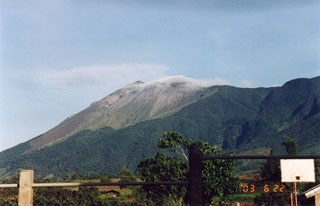Report on Kanlaon (Philippines) — 27 November-3 December 2024
Smithsonian Institution / US Geological Survey
Weekly Volcanic Activity Report, 27 November-3 December 2024
Managing Editor: Sally Sennert.
Please cite this report as:
Global Volcanism Program, 2024. Report on Kanlaon (Philippines) (Sennert, S, ed.). Weekly Volcanic Activity Report, 27 November-3 December 2024. Smithsonian Institution and US Geological Survey.
Kanlaon
Philippines
10.4096°N, 123.13°E; summit elev. 2422 m
All times are local (unless otherwise noted)
The Philippine Institute of Volcanology and Seismology (PHIVOLCS) reported a continuing eruption at Kanlaon during 26 November-3 December. The seismic network recorded 5-26 daily volcanic earthquakes, and sulfur dioxide emissions ranged from 2,524 to 9,377 tonnes per day. Moderate gas-and-steam emissions rose 100-750 m above the summit and drifted mainly SW, W, and NE. There were 1-5 daily ash emission events during 26-29 November and on 1 December, with each lasting 5-35 minutes. According to the Tokyo VAAC the ash emissions on those same days rose 2.7-3.4 km (9,000-11,000 ft) a.s.l. and drifted SW, NNW, and NE. The Alert Level remained at 2 (on a scale of 0-5) and PHIVOLCS reminded the public to remain outside of the 4-km-radius Permanent Danger Zone and warned pilots not to fly close to the volcano.
Geological Summary. Kanlaon volcano (also spelled Canlaon) forms the highest point on the Philippine island of Negros. The massive andesitic stratovolcano is covered with fissure-controlled pyroclastic cones and craters, many of which are filled by lakes. The largest debris avalanche known in the Philippines traveled 33 km SW from Kanlaon. The summit contains a 2-km-wide, elongated northern caldera with a crater lake and a smaller but higher active vent, Lugud crater, to the south. Eruptions recorded since 1866 have typically consisted of phreatic explosions of small-to-moderate size that produce minor local ashfall.
Sources: Philippine Institute of Volcanology and Seismology (PHIVOLCS), Tokyo Volcanic Ash Advisory Center (VAAC)

